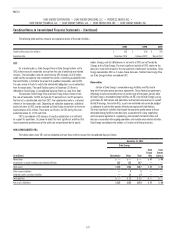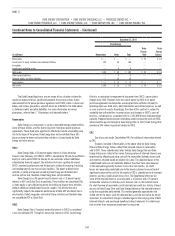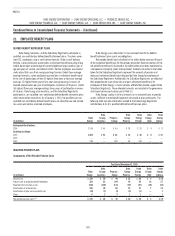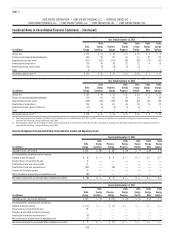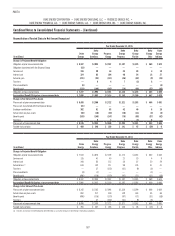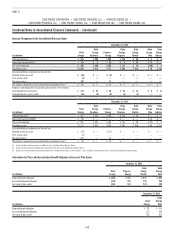Duke Energy 2015 Annual Report Download - page 200
Download and view the complete annual report
Please find page 200 of the 2015 Duke Energy annual report below. You can navigate through the pages in the report by either clicking on the pages listed below, or by using the keyword search tool below to find specific information within the annual report.
180
PART II
DUKE ENERGY CORPORATION • DUKE ENERGY CAROLINAS, LLC • PROGRESS ENERGY, INC. •
DUKE ENERGY PROGRESS, LLC. • DUKE ENERGY FLORIDA, LLC. • DUKE ENERGY OHIO, INC. • DUKE ENERGY INDIANA, INC.
Combined Notes to Consolidated Financial Statements – (Continued)
December 31, 2014
Duke Energy
(in millions) Renewables Other Total
Duke
Energy
Ohio
Duke
Energy
Indiana
Receivables $ — $ — $ — $ 91 $ 113
Investments in equity method unconsolidated affiliates 150 38 188 — —
Intangibles — — — — —
Investments and other assets — 4 4 — —
Total assets $ 150 $ 42 $ 192 $ 91 $ 113
Other current liabilities — 3 3 — —
Deferred credits and other liabilities — 14 14 — —
Total liabilities $ — $ 17 $ 17 $ — $ —
Net assets $ 150 $ 25 $ 175 $ 91 $ 113
The Duke Energy Registrants are not aware of any situations where the
maximum exposure to loss significantly exceeds the carrying values shown
above except for the power purchase agreement with OVEC, which is discussed
below, and various guarantees, some of which are reflected in the table above
as Deferred credits and other liabilities. For more information on various
guarantees, refer to Note 7, “Guarantees and Indemnifications.”
Renewables
Duke Energy has investments in various renewable energy project entities.
Some of these entities are VIEs due to long-term fixed price power purchase
agreements. These fixed price agreements effectively transfer commodity price
risk to the buyer of the power. Duke Energy does not consolidate these VIEs
because power to direct and control key activities is shared jointly by Duke
Energy and other owners.
Other
Duke Energy holds a 50 percent equity interest in Duke-American
Transmission Company, LLC (DATC). DATC is considered a VIE due to insufficient
equity at risk to permit DATC to finance its own activities without additional
subordinated financial support. The activities that most significantly impact
DATC’s economic performance are the decisions related to investing in existing
and development of new transmission facilities. The power to direct these
activities is jointly and equally shared by Duke Energy and the other joint
venture partner and, therefore, Duke Energy does not consolidate.
Duke Energy has a 40 percent equity interest and a 7.5 percent equity
interest in ACP and Sabal Trail, respectively. These entities are considered VIEs
as their equity is not sufficient to permit the entities to finance their activities
without additional subordinated financial support. The activity that most
significantly impacts the economic performance of both ACP and Sabal Trail is
construction. Duke Energy does not control these activities and therefore does
not consolidate ACP or Sabal Trail.
OVEC
Duke Energy Ohio’s 9 percent ownership interest in OVEC is considered
a non-consolidated VIE. Through its ownership interest in OVEC, Duke Energy
Ohio has a contractual arrangement to buy power from OVEC’s power plants
through June 2040. Proceeds from the sale of power by OVEC to its power
purchase agreement counterparties are designed to be sufficient to meet its
operating expenses, fixed costs, debt amortization and interest expense, as well
as earn a return on equity. Accordingly, the value of this contract is subject to
variability due to fluctuations in power prices and changes in OVEC’s costs of
business, including costs associated with its 2,256 MW of coal-fired generation
capacity. Proposed environmental rulemaking could increase the costs of OVEC,
which would be passed through to Duke Energy Ohio. In 2014, Duke Energy Ohio
recorded a $94 million impairment related to OVEC.
CRC
See discussion under Consolidated VIEs for additional information related
to CRC.
Amounts included in Receivables in the above table for Duke Energy
Ohio and Duke Energy Indiana reflect their retained interest in receivables
sold to CRC. These subordinated notes held by Duke Energy Ohio and Duke
Energy Indiana are stated at fair value. Carrying values of retained interests are
determined by allocating carrying value of the receivables between assets sold
and interests retained based on relative fair value. The allocated bases of the
subordinated notes are not materially different than their face value because
(i) the receivables generally turnover in less than two months, (ii) credit
losses are reasonably predictable due to the broad customer base and lack of
significant concentration and (iii) the equity in CRC is subordinate to all retained
interests and thus would absorb losses first. The hypothetical effect on fair
value of the retained interests assuming both a 10 percent and a 20 percent
unfavorable variation in credit losses or discount rates is not material due to
the short turnover of receivables and historically low credit loss history. Interest
accrues to Duke Energy Ohio and Duke Energy Indiana on the retained interests
using the acceptable yield method. This method generally approximates the
stated rate on the notes since the allocated basis and the face value are nearly
equivalent. An impairment charge is recorded against the carrying value of both
retained interests and purchased beneficial interest whenever it is determined
that an other-than-temporary impairment has occurred.











